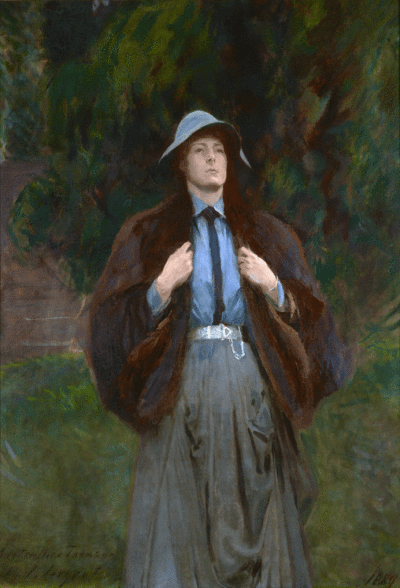

Queer Places:
Charleton House, Colinsburgh, Leven KY9 1HG, Regno Unito
Villa Il Palmerino, Via del Palmerino, 10, 50137 Firenze FI, Italia
Kilconquhar Parish Church, Leven KY9 1JZ, Regno Unito
 Clementina
"Kit" Caroline Anstruther-Thomson (1857–1921) was a Scottish author and art
theorist. She was known for writing and lecturing on experimental aesthetics
during the Victorian era.[1]
Her collaboration with Vernon
Lee in the 1890s inspired Lee's growing interests in the psychological
aspect of aesthetics later in her career.[2]
Vernon
Lee lived most of the time in Italy, where she was much given to visiting
churches, museums and galleries; doing this in the 1890s with her lover, the
painter Clementina
Anstruther-Thomson, she decided to undertake a study of what happens to
the human body when the mind is occupied with the vista of an aesthetic
object: a building, a decorative jar, a painting. Anstruther-Thomson kept a
diary in which she recorded her reactions, how looking at art made her feel.
She noted her respiration and heart rate, balance, muscular tension, the
manner and speed with which her right and left lungs filled with air. For
example, looking at the Gothic-Renaissance façade of Santa Maria Novella in
Florence one day, she observed that her balance changed and her breathing
deepened. The composer Ethel Smyth, who had
also had a relationship with Lee, made snide comments about what Lee and
Anstruther-Thompson were doing, ‘experimenting’ in art galleries.
Clementina
"Kit" Caroline Anstruther-Thomson (1857–1921) was a Scottish author and art
theorist. She was known for writing and lecturing on experimental aesthetics
during the Victorian era.[1]
Her collaboration with Vernon
Lee in the 1890s inspired Lee's growing interests in the psychological
aspect of aesthetics later in her career.[2]
Vernon
Lee lived most of the time in Italy, where she was much given to visiting
churches, museums and galleries; doing this in the 1890s with her lover, the
painter Clementina
Anstruther-Thomson, she decided to undertake a study of what happens to
the human body when the mind is occupied with the vista of an aesthetic
object: a building, a decorative jar, a painting. Anstruther-Thomson kept a
diary in which she recorded her reactions, how looking at art made her feel.
She noted her respiration and heart rate, balance, muscular tension, the
manner and speed with which her right and left lungs filled with air. For
example, looking at the Gothic-Renaissance façade of Santa Maria Novella in
Florence one day, she observed that her balance changed and her breathing
deepened. The composer Ethel Smyth, who had
also had a relationship with Lee, made snide comments about what Lee and
Anstruther-Thompson were doing, ‘experimenting’ in art galleries.
Anstruther-Thomson was born to John Anstruther-Thomson of Charleton and Carntyne, and Caroline Maria Agnes Robina Gray in an aristocratic family. Her grandfather, also John Anstruther-Thomson, was a career officer in the British Territorial Army.[3]
The aesthetic movement in the United Kingdom began in the 1860s during the Victorian period.[4] In Victorian literature, writers of the aesthetic movement focused on the sensual aspect of aesthetics. Anstruther-Thomson in particular was keen on experiencing art physically with her body.[2] In one of the lectures titled "What Patterns Do to Us" given by Anstruther-Thomson, she encouraged the audience to engage with a patterned vase and "feel its effect on their bodies".[5]
Vernon Lee was already familiar with Anstruther-Thomson prior to meeting her. Contemporary writers have described Anstruther-Thomson as having the physique that resembles the ideals from ancient Greek sculpture, and Lee frequently described her obsession with Anstruther-Thomson's body in her writings.[6] When Lee observed art with Anstruther-Thomson, her aesthetic experience was based on "lesbian desire" of Anstruther-Thomson's body that embodied Greek ideals.[2]
Anstruther-Thomson first met Vernon Lee in 1888, and for the next twelve years the two women openly lived together, as "lovers, friends, and co-authors".[7][8] Living as expatriates in Italy, they often travelled back and forth to Britain. In their time together, they took aesthetics experiments and recorded their findings. Throughout the 1890s, Anstruther-Thomson and Lee visited many museums across continental Europe and observed many art works. In their observation, they recorded in writing on how their body responded to art works.[9]
In 1897, they published the combined findings in the article "Beauty and Ugliness", which investigates the physiology of aesthetics. Their research was based on the James–Lange theory of how the human body responds to stimulation and triggers emotion.[10] Many of the findings, however, were not taken seriously as both their professional and romantic relationship was "attacked"[11] by their contemporaries, receiving "severe criticisms" from friends.[7]
Villa Il Palmerino
After the publication of "Beauty and Ugliness", Anstruther-Thomson gradually drifted away from Lee, and eventually broke off the relationship in 1898.[8] They remained close friends until the death of Anstruther-Thomson in 1921.[7] Later in her life, Anstruther-Thomson worked closely with the Girl Guides of America. Many of the earlier leaders were single women, and some were lesbian as well, for whom Guiding provided a safe refuge.[12] Anstruther-Thomson was both an organizer and trainer, and held the position of County Commissioner until her death.[12] She was buried with her family in Kilconquhar Parish Churchyard, Kilconquhar.[3]
Her writings on aesthetics were collected and published posthumously by Lee in Art and Man in 1924, with an introduction, also by Lee, that describes their collaboration in experiencing art.[13][14]
My published books: